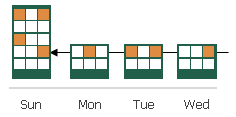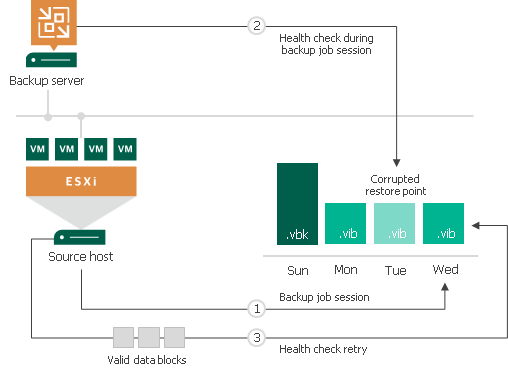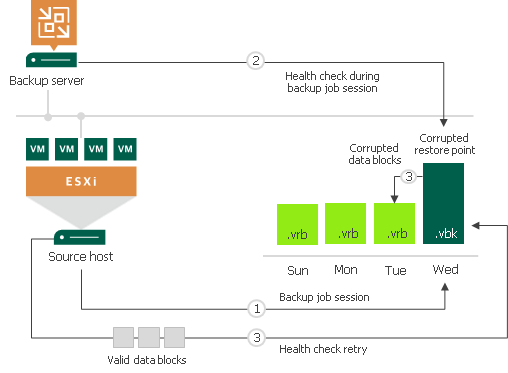备份文件健康检查
You can instruct Veeam Backup & Replication to periodically perform a health check for the latest restore point in the backup chain. During the health check, Veeam Backup & Replication performs a CRC check for metadata and a hash check for VM data blocks in the backup file to verify their integrity. The health check helps make sure that the restore point is consistent, and you will be able to restore data from this restore point.
The health check can be performed for all types of backup chains:
- Forever forward incremental
- Forward incremental
- Reverse incremental backup chains
To run the health check periodically, you must enable the Perform backup files health check option in the backup job settings and define the health check schedule. By default, the health check is performed on the last Friday of every month. You can change the schedule and run the health check weekly or monthly on specific days.
Note |
Veeam Backup & Replication performs the health check during the first job session on the day when the health check is scheduled. If another job session runs on the same day, Veeam Backup & Replication will not perform the health check during this job session. For example, if the job is scheduled to run several times on Saturday, and the health check is scheduled on Saturday, the health check will only be performed during the first backup job session on Saturday. |

Verification Content
The health check always verifies only the latest restore point in the backup chain. In case of forever forward incremental and forward incremental backup chains, if the latest restore point is incomplete, the health check verifies the restore point preceding the latest one.
Bear in mind that the health check procedure verifies not the latest backup file in the backup chain, but the latest restore point for a VM. The latest restore point corresponds to the state of the VM at the date and time when the latest backup file for this VM was created. Data blocks that are required to "compose" the VM latest state are typically spread out across several backup files in the backup chain. Therefore, to verify the latest state of the VM, Veeam Backup & Replication must open several backup files in the backup chain and read data blocks from these backup files. For this reason, the health check procedure may take long.

The health check verifies only those virtual disks of a VM that are available in the latest restore point. For example, you added a VM with 3 virtual disks to a backup job. The VM was backed up Sunday through Tuesday. On Wednesday, you removed 1 virtual disk, and Veeam Backup & Replication run the health check for the VM. During the health check, Veeam Backup & Replication will verify only the 2 remaining virtual disks.
The health check verifies only those VMs that are available in the latest restore point. For example, you added 2 VMs to a backup job and run the job for some time. The health check verified 2 VMs. If you remove 1 VM from the backup job, the next scheduled health check run will verify the latest unverified restore point for the removed VM, and the latest restore point for the remaining VM. In future, the health check will verify only the restore point for the remaining VM in the job.

Limitations for Health Check
- The health check is not performed during an active full backup job session started manually or automatically by schedule.
- The health check is not performed for offloaded restore points. For more information, see Capacity Tier.
- [For per-machine backup chains] If you add a new VM to an existing backup job that has been run for some time, Veeam Backup & Replication will perform the health check for it during the next incremental backup job session for the added VM.
How Health Check Works
When Veeam Backup & Replication saves a new restore point to the backup repository, it calculates CRC values for backup metadata and hash values for data blocks of VM disk in the backup file, and saves these values in the metadata of the backup file, together with VM data. During the health check session, Veeam Backup & Replication uses these values to make sure that a verified restore point is consistent.
Note |
If you perform health check for encrypted backup files, Veeam Backup & Replication will pass encryption keys to the regular backup repository or cloud repository. For more information on encryption, see Data Encryption. |
Veeam Backup & Replication uses different mechanisms of health check for different types of backup chains:
Forever Forward Incremental and Forward Incremental Backup Chains
The health check for forward incremental backup chains is performed in the following way:
- At the end of the backup job session, Veeam Backup & Replication performs the health check. It calculates CRC values for backup metadata and hash values for VM disks data blocks in the backup file and compares them with the CRC and hash values that are already stored in the backup file.
During the health check, Veeam Backup & Replication verifies the latest restore point in the backup chain (restore point created with the current backup job session — the session during which the health check is performed). If the latest restore point in the backup chain is incomplete, Veeam Backup & Replication checks the restore point preceding the latest one.
- If the health check does not detect data corruption, the backup job session completes in a regular way.
If the health check detects corrupted data, Veeam Backup & Replication completes the backup job with the Error status and starts the health check retry process. The health check retry starts as a separate backup job session.
Depending on the revealed data corruption, Veeam Backup & Replication performs the following actions:
- If the health check has detected corrupted backup metadata in the full backup file, Veeam Backup & Replication marks the backup chain starting from this full restore point as corrupted in the configuration database. During the health check retry, Veeam Backup & Replication transports data blocks of the whole VM image from the source datastore, creates a new full backup file in the backup repository and saves transported data blocks to it.
- If the health check has detected corrupted backup metadata in the incremental backup file, Veeam Backup & Replication removes information about this incremental restore point and subsequent incremental restore points from the configuration database. During the health check retry, Veeam Backup & Replication transports incremental data relatively the latest valid restore point in the backup chain from the source datastore, creates a new incremental backup file in the backup repository and saves transported data blocks to it.
- If the health check has detected corrupted VM disk blocks in the full or incremental backup file, Veeam Backup & Replication marks the restore point that includes the corrupted data blocks and subsequent incremental restore points as corrupted in the configuration database. During the health check, Veeam Backup & Replication transports data blocks from the source datastore. In addition, Veeam Backup & Replication transports data blocks that have changed since the backup job session that has triggered the health check. Veeam Backup & Replication stores these data blocks to the latest restore point that has been created with the current backup job session (session that has triggered the health check retry).

Reverse Incremental Backup Chains
In case of reverse incremental backup chains, the health check always verifies only the latest restore point in the backup chain, which is always a full backup file.
The health check is performed in the following way:
- At the end of the backup job session, Veeam Backup & Replication verifies the full backup file. Veeam Backup & Replication calculates CRC values for backup metadata and hash values for VM disks data blocks in the full backup file, and compares them with the CRC and hash values that are already stored in the full backup file.
- If the health check does not detect data corruption, the backup job session completes in a regular way.
If the health check detects corrupted data, Veeam Backup & Replication completes the backup job with the Error status and starts the health check retry process. The health check retry starts as a separate backup job session.
Depending on the revealed data corruption, Veeam Backup & Replication performs the following actions:
- If the health check has detected corrupted backup metadata in the full backup file, Veeam Backup & Replication marks the whole backup chain (full backup file and preceding reverse incremental backup files) as corrupted in the configuration database. During the health check retry, Veeam Backup & Replication transports data blocks of the whole VM image from the source datastore, creates a new full backup file in the backup repository and saves transported data blocks to it.
- If the health check has detected corrupted VM disk blocks in the full backup file, Veeam Backup & Replication marks the full backup file and preceding reverse incremental backup files as corrupted in the configuration database. During the health check retry, Veeam Backup & Replication transports data blocks from the source datastore. In addition, Veeam Backup & Replication transports data blocks that have changed since the backup job session that has triggered the health check. Veeam Backup & Replication stores these data blocks to the existing full backup file in the backup repository. Corrupted data blocks that have been replaced with data blocks from the source datastore are stored to an existing reverse incremental backup file preceding the full backup file.

Health Check Retries
The health check itself is started during the backup job session or the job retry session if the backup job session has failed. If attempts are not successful, Veeam Backup & Replication performs the health check during the last job retry in any case.
If the health check detects corrupted data, Veeam Backup & Replication completes the backup job with the Error status and starts the health check retry process. The health check retry starts as a separate backup job session. During the health check retry, Veeam Backup & Replication attempts to transport data blocks for the corrupted restore point from the source datastore.
For scheduled jobs, the number of health check retries is equal to the number of job retries specified in the job settings. For jobs started manually, Veeam Backup & Replication performs 1 health check retry.
Note |
If Veeam Backup & Replication fails to fix the corrupted data during all health check retries, you must retry the job manually. In this case, Veeam Backup & Replication will transport the required data blocks from the source datastore to fix the latest restore point. If the latest restore point in the backup chain is incomplete, Veeam Backup & Replication will attempt to fix the restore point preceding the latest one. |
Related Topics